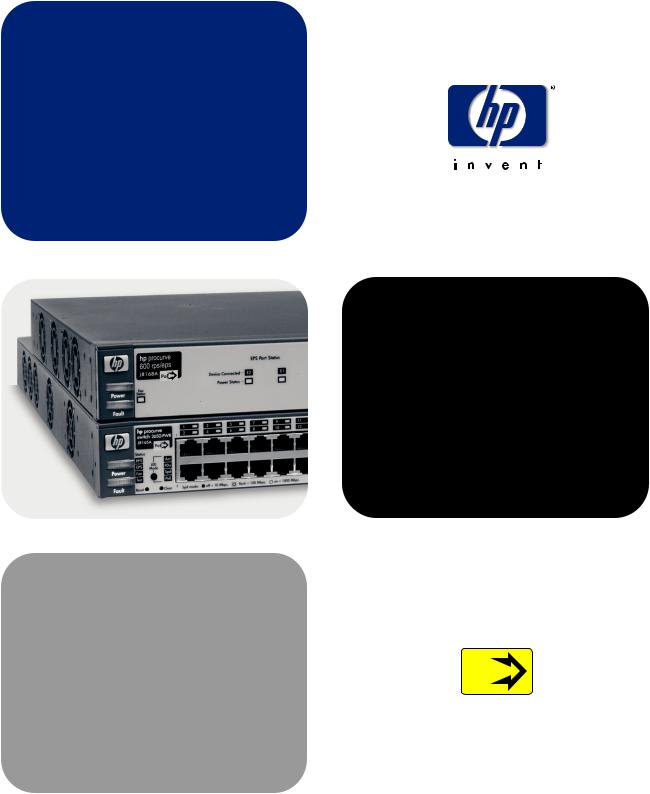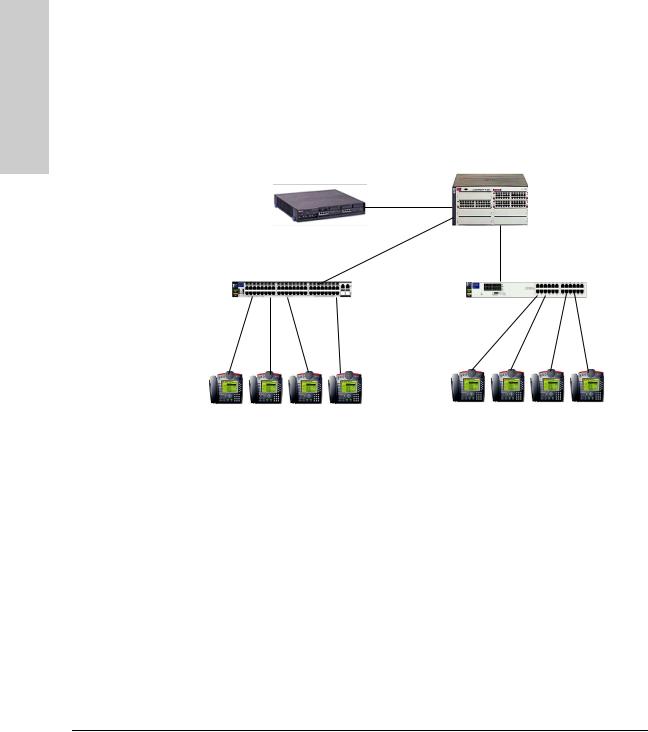HP J8168A, J8165A, J8164A, J8161A User Manual

PoE planning and implementation guide
hp procurve
www.hp.com/go/hpprocurve |
PoE |
Power over Ethernet Devices

HP ProCurve
PoE Planning and
Implementation Guide

© Copyright 2003 Hewlett-Packard Development Company, L.P. The information contained herein is subject to change without notice.
This document contains proprietary information, which is protected by copyright. No part of this document may be photocopied, reproduced, or translation into another language without the prior written consent of Hewlett-Packard.
Publication Number
5990-6045 November 2003 Edition 1
Applicable Products
HP ProCurve Switch 2626-PWR |
(J8164A) |
HP ProCurve Switch 2650-PWR |
(J8165A) |
HP ProCurve Switch xl PoE Module |
(J8161A) |
HP ProCurve 600 Redundant and |
(J8168A) |
External Power Supply |
Trademark Credits
Windows NT®, Windows®, and MS Windows® are US registered trademarks of Microsoft Corporation.
Disclaimer
HEWLETT-PACKARD COMPANY MAKES NO WARRANTY OF ANY KIND WITH REGARD TO THIS MATERIAL, INCLUDING, BUT NOT LIMITED TO, THE IMPLIED WARRANTIES OF MERCHANTABILITY AND FITNESS FOR A PARTICULAR PURPOSE. Hewlett-Packard shall not be liable for errors contained herein or for incidental or consequential damages in connection with the furnishing, performance, or use of this material.
The only warranties for HP products and services are set forth in the express warranty statements accompanying such products and services. Nothing herein should be construed as constituting an additional warranty. HP shall not be liable for technical or editorial errors or omissions contained herein.
Hewlett-Packard assumes no responsibility for the use or reliability of its software on equipment that is not furnished by Hewlett-Packard.
Warranty
See the Customer Support/Warranty booklet included with the product.
A copy of the specific warranty terms applicable to your HewlettPackard products and replacement parts can be obtained from your HP Sales and Service Office or authorized dealer.

Contents
1 Introduction
Overview . . . . . . . . . . . . . . . . . . . . . . . . . . . . . . . . . . . . . . . . . . . . . . . . . . . . . . 1-1
Power Through the Cable . . . . . . . . . . . . . . . . . . . . . . . . . . . . . . . . . . . 1-3
PoE Capabilities of the Products . . . . . . . . . . . . . . . . . . . . . . . . . . . . . . 1-3
2 Operating Rules
HP 600 RPS/EPS Operation . . . . . . . . . . . . . . . . . . . . . . . . . . . . . . . . . . . . . . . 2-1
Redundant Switch Power . . . . . . . . . . . . . . . . . . . . . . . . . . . . . . . . . . . . . . . . |
2-1 |
External Switch Power . . . . . . . . . . . . . . . . . . . . . . . . . . . . . . . . . . . . . . . . . . |
2-2 |
EPS Power Allocation . . . . . . . . . . . . . . . . . . . . . . . . . . . . . . . . . . . . . . . |
2-2 |
Maximum PoE Power . . . . . . . . . . . . . . . . . . . . . . . . . . . . . . . . . . . . . . . |
2-3 |
PoE Power With and Without EPS . . . . . . . . . . . . . . . . . . . . . . . . . . . . . |
2-3 |
Switch Port Priority . . . . . . . . . . . . . . . . . . . . . . . . . . . . . . . . . . . . . . . . . |
2-4 |
Switch Priority Class . . . . . . . . . . . . . . . . . . . . . . . . . . . . . . . . . . . . . . . . . |
2-5 |
Line Loss . . . . . . . . . . . . . . . . . . . . . . . . . . . . . . . . . . . . . . . . . . . . . . . . . . |
2-5 |
PD Power Classification . . . . . . . . . . . . . . . . . . . . . . . . . . . . . . . . . . . . . |
2-5 |
3 Planning
PD Power Requirements . . . . . . . . . . . . . . . . . . . . . . . . . . . . . . . . . . . . . . . . . 3-1
Supported Products . . . . . . . . . . . . . . . . . . . . . . . . . . . . . . . . . . . . . . . . . . . . . 3-2
Number of PDs per Switch . . . . . . . . . . . . . . . . . . . . . . . . . . . . . . . . . . . . . . . 3-2
Planning Your PoE Configuration . . . . . . . . . . . . . . . . . . . . . . . . . . . . . . . . . 3-2
HP ProCurve 2626-PWR Configurations . . . . . . . . . . . . . . . . . . . . . . . . 3-3 With an HP 600 RPS/EPS Powering One Switch . . . . . . . . . . . . . . 3-3 With an HP 600 RPS/EPS Powering Two Switches . . . . . . . . . . . . 3-4
HP ProCurve 2650-PWR Configurations . . . . . . . . . . . . . . . . . . . . . . . . 3-5 With an HP 600 RPS/EPS Powering One Switch . . . . . . . . . . . . . . 3-6 With an HP 600 RPS/EPS Powering Two Switches . . . . . . . . . . . . 3-7
i

HP ProCurve Switch xl PoE Module Configurations . . . . . . . . . . . . . . 3-8 With an HP 600 RPS/EPS Powering One Module . . . . . . . . . . . . . . 3-8 With an HP 600 RPS/EPS Powering Two Modules . . . . . . . . . . . . 3-9
Infrastructure Requirements . . . . . . . . . . . . . . . . . . . . . . . . . . . . . . . . . . . . . 3-10
Glossary
Index
ii

1
Introduction
This chapter provides an overview of Power over Ethernet (PoE) and a list of reasons why a user might want to implement PoE in their environment. It discusses how PoE transmits power over twisted pair cable and the capabili ties of the devices used to provide PoE.
Overview
Power over Ethernet technology allows IP telephones, wireless LAN Access Points and other appliances to receive power as well as data over existing LAN cabling, without needing to modify the existing Ethernet infrastructure.
IEEE 802.3af is an extension to the existing Ethernet standards. Power Over Ethernet is likely to become a standard feature of ethernet switches in a few years, as the cost of adding power supplies to the Ethernet switches is going to be small. It offers the first truly international standard for power distribu tion (consider how many different AC power plugs exist worldwide).
Almost all appliances require both data connectivity and a power supply. Just as telephones are powered from the telephone exchange through the same twisted pair that carries the voice, we can now do the same thing with Ethernet devices.
The technology is bound to make a big impact in the world of embedded computing. In the realm of embedded computers, where the systems are increasingly connected to LANs and the internet, the advantages of providing power and data through a single cable should be obvious. Consider a typical application: a system for a car park that includes security cameras, informa tion signs, call-for-help telephones and vehicle sensors. Such a system is distributed over a significant area, where mains power is not easily available. A single link to a PoE Ethernet Switch makes implementing this system less expensive and faster than using a non-PoE switch.
Introduction
1-1

Introduction
Overview
Introduction
Power Over Ethernet connections to embedded computers will allow much cheaper installation (no AC cabling, lower labor costs), facilitate updating the installation and repositioning of sensors without electricians, while main taining full control over every node through the Internet, with VoIP and webcam telephony. Functionality can be changed by downloading new software through the network.
Figure 1 shows a typical system implemented to power telephones. The PoE Ethernet switches are installed to supply power over the twisted pair LAN cables to run phones or other appliances as required.
Mitel 3300 IP PBX
5300xl
HP PoE switch |
HP PoE switch |
Figure 1-1. Example of a Typical Implementation
Here are some reasons why you might want to do this:
■Only one set of wires to bring to your appliance - simplifies installation and saves space.
■There is no need to pay for additional electrical power runs or to delay your installation schedule to make themsaves time and money.
■The appliance can be easily moved, to wherever you can lay a LAN cable - minimal disruption to the workplace.
■Safer - no AC voltages need to be added for additional network devices.
■As well as the data transfer to and from the appliance, you can use SNMP network management infrastructure to monitor and control the appliances.
■Appliances can be shut down or reset remotely - no need for a reset button or power switch.
■When implementing wireless LAN systems it simplifies the RF survey task, as the access point can easily be moved and wired in.
1-2

Introduction
Overview
Power Through the Cable
A standard CAT5 Ethernet cable has four twisted pairs, but only two of these pairs are used for 10Base-T and 100Base-TX data. The specification allows two options for using these cables for power:
■The spare pairs are used. The pair on pins 4 and 5 are connected together and form the positive supply, and the pair on pins 7 and 8 are connected and form the negative supply.
■The data pairs are used. Since Ethernet pairs are transformer coupled at each end, it is possible to apply DC power to the center tap of the isolation transformer without upsetting the data transfer. In this mode of operation the pair on pins 3 and 6 and the pair on pins 1 and 2 can be of either polarity.
The standard does not allow both pairs (spare and data) to be used - a choice must be made. The Power Sourcing Equipment (PSE) applies power to either set of wires. Hewlett-Packard has chosen to supply PoE power over the data pair. The Powered Device (PD) must be able to accept power from both options.
An obvious requirement of the specification is to prevent damage to existing Ethernet equipment. A discovery process, run from the PSE, examines the Ethernet cables, looking for devices that comply with the specification. It does this by applying a small current-limited voltage to the cable and checks for the presence of a 25k ohm resistor in the remote device. Only if the resistor is present, will the full wattage be applied, but this is still current-limited to prevent damage to cables and equipment in fault conditions.
The Powered Device must continue to draw a minimum current. If it does not (for example, when the device is unplugged) then the PSE removes the power and the discovery process begins again.
PoE Capabilities of the Products
The HP ProCurve PoE switch devices are multiport switches that can be used to build high-performance switched workgroup networks with PoE. These switches are store-and-forward devices that offers low latency for high-speed networking. The HP ProCurve PoE switch devices are designed to support Redundant Power Supply and Power over Ethernet (PoE) technologies.
The 2650-PWR and 2626-PWR switches have 48 and 24 auto-sensing 10/ 100Base-TX RJ-45 ports, respectively, and two dual-personality ports—either auto-sensing 10/100/1000Base-T RJ-45, or mini-GBIC. The dual-personality ports do not support PoE.
Introduction
1-3

Introduction
Overview
Introduction
The HP ProCurve Switch xl PoE Module (J8161A) is a module for the HP ProCurve 5300 xl Switch and has 24 auto-sensing 10/100-TX RJ-45 ports. All 24 ports are capable of supplying PoE power. However, for the module itself to be able to supply PoE power it first must be connected to an EPS port on an HP ProCurve 600 Redundant and External Power Supply (J8168A), hereafter referred to as the HP 600 RPS/EPS.
The Switch 2600-PWR Series devices can be connected to an HP 600 RPS/EPS and receive full redundant power from the RPS part of the unit for switch operation, if the internal power supply in the switch fails. If multiple switches are connected to the RPS ports and several switches lose power at the same time, the switch attached to the lowest RPS port number receives power. The HP 600 RPS/EPS unit can provide all the power necessary to keep the switch running.
EPS power from the HP 600 RPS/EPS device is the PoE capability of the device and supplies backup and additional power for the ports of the 2626-PWR, 2650-PWR switch devices. It also provides PoE power to the HP ProCurve Switch xl PoE Module.
These switch devices are designed to be used primarily as high-density wiring closet or desktop switches. With these switches you can directly connect computers, printers, and servers to provide dedicated bandwidth to those devices, and you can build a switched network infrastructure by connecting the switch to hubs, other switches, or routers. In addition, they support the PoE standard, IEEE 802.3af, and can supply power over a twisted-pair cable to power devices such as telephones and wireless access points.
1-4
